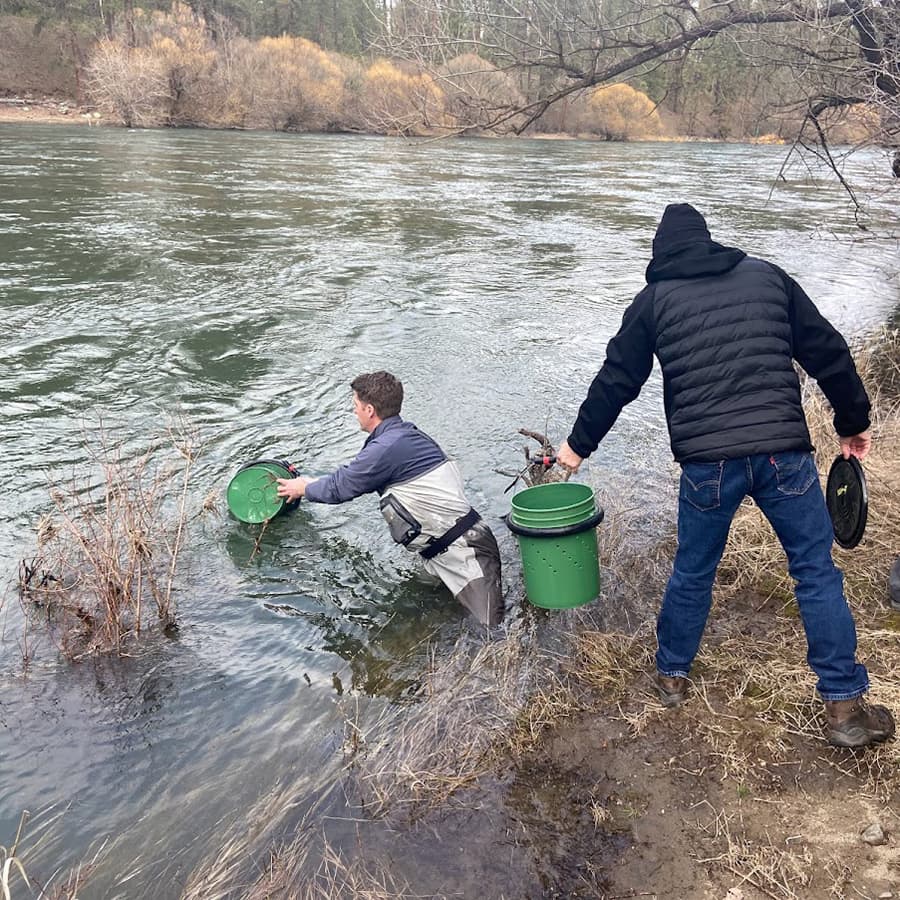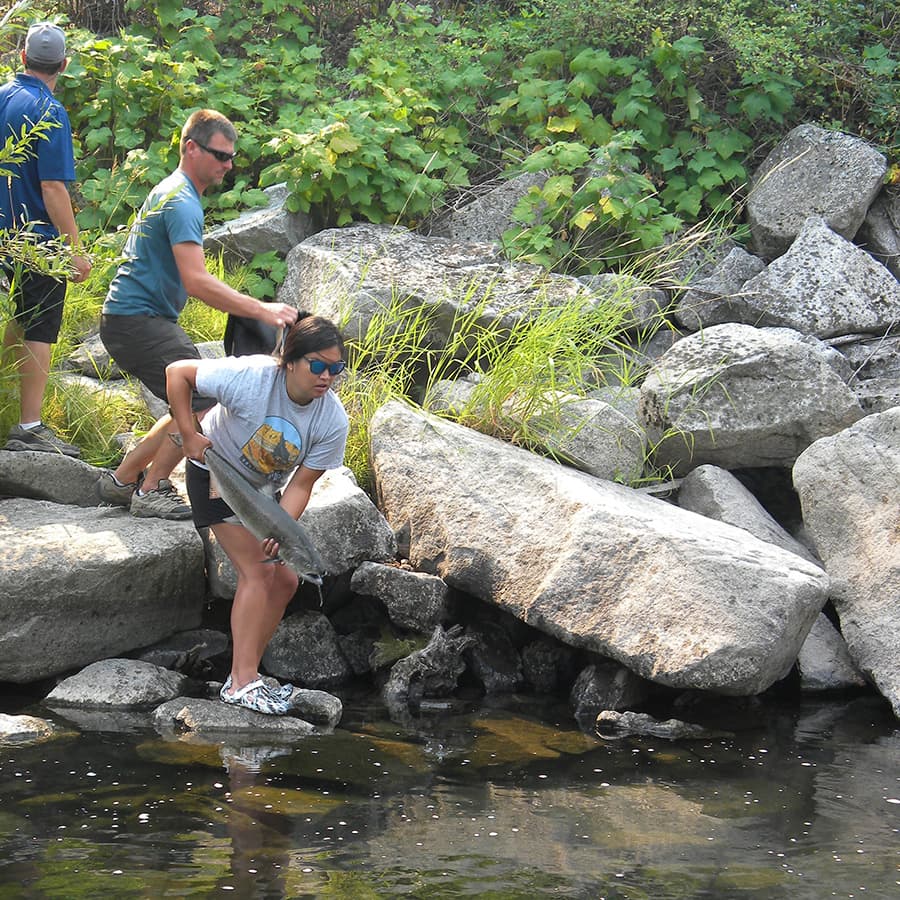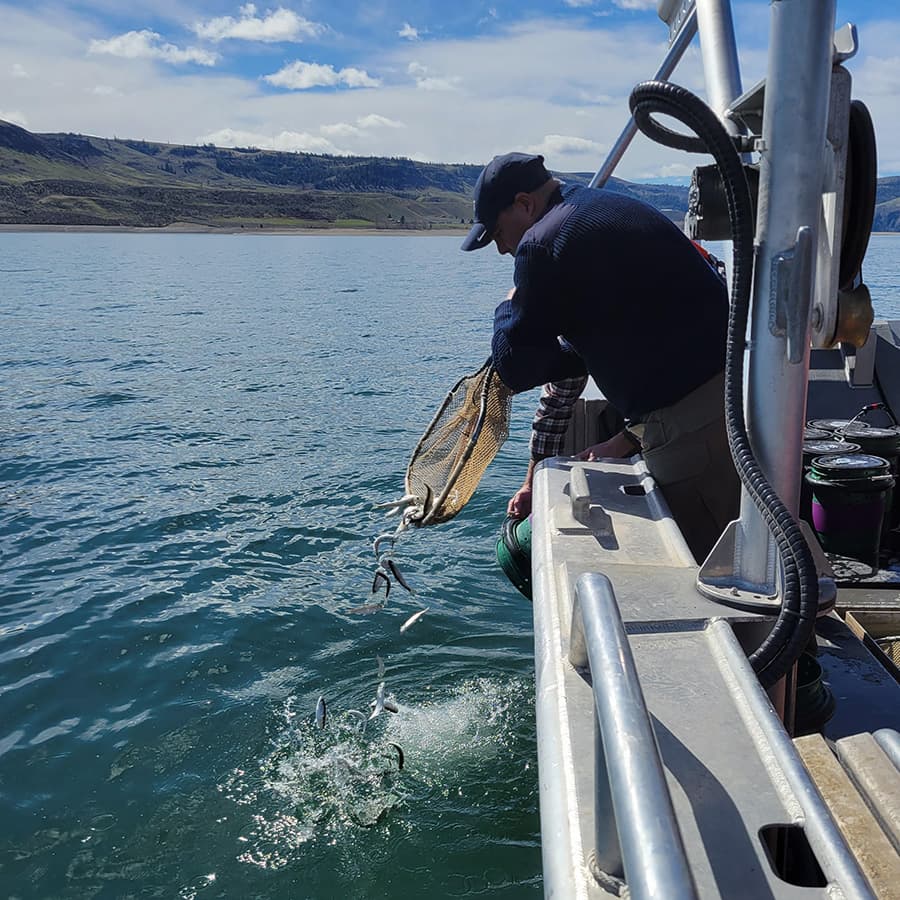Documents
The Phase 2 Implementation Plan “P2IP”: A stepwise and scientifically adaptive approach to test the feasibility of restoring salmon to the Upper Columbia River basin that is focused on collaboration, cost effectiveness, and benefits for the entire region.
Background
In 2015, the Columbia Basin Tribes and First Nations (CBTFN) finalized the Joint Paper “Fish Passage and Reintroduction into the U.S. and Canadian Upper Columbia Basin” (CBTFN 2015). The Joint Paper describes a four phased approach to guide the development of fish passage and reintroduction efforts upstream of Chief Joseph and Grand Coulee dams. An initial draft of the phased approach was refined and adopted by the Northwest Power and Conservation Council (NPCC) in the 2014 Columbia River Basin Fish and Wildlife Program (NPCC 2014) prior to the finalization and publication of the Joint Paper.
In 2019 the Upper Columbia United Tribes (UCUT) completed Phase 1 and published its findings (UCUT 2019). Phase 1 studies consisted of a reintroduction risk and donor stock assessment, multiple assessments of habitat availability and suitability, an evaluation of fish passage technologies at high-head dams, Grand Coulee and Chief Joseph dams’ operations and configurations, and life cycle modeling. Results from these studies indicate reintroduction of salmon to the blocked area could result in the production of 76,000 adult Sockeye salmon and 44,000 adult summer/fall Chinook given current habitat conditions, available stocks of fish and with the construction of effective fish passage systems at existing dams.
Following publication of the Phase 1 Report it was reviewed by the NPCC’s Independent Scientific Advisory Board (ISAB; ISAB 2019). The ISAB found it reasonable that salmon reintroduction to blocked areas could be successful but noted that there is considerable uncertainty around dam passage and reservoir survival, the resulting number of adult salmon that will return, and the type of management required to sustain them. They suggested that a strategic implementation plan with an adaptive management process is needed to address uncertainties.



Phase 2 Implementation
This Phase 2 implementation plan describes research needed to resolve Phase 1 uncertainties and the tools that will be used to guide management actions and evaluate their success. The objectives of Phase 2 are:
- Test the key biological assumptions made in Phase 1 considered critical for the success of the reintroduction effort.
- Establish the sources (and regulatory approvals) of Chinook (Oncorhynchus tshawytscha) and Sockeye (Oncorhynchus nerka) salmon donor stocks and broodstock that will be used to produce the juveniles and adults required to conduct biological studies and test fish passage facilities.
- Develop the interim hatchery and passage facilities required to evaluate reintroduction.
- Provide the data and analyses needed for Phase 3 decision-making. This includes data necessary to determine the need, type, and costs of permanent fish passage systems and hatchery production facilities.
- Conduct the studies and implement Phase 2 reintroduction work such that it does not:
- introduce ESA-listed species into the blocked area
- require major operational changes to the hydrosystem such as power production, flood control or irrigation.
- reduce salmon harvest downstream
Scientific Framework
During Phase 1, a life cycle model (LCM) was developed to evaluate the feasibility of reintroduction. This new LCM is like those used in Willamette River fish passage planning. During Phase 2, locally collected empirical data will replace LCM assumptions used in Phase 1. The LCM will be continually updated as results from Phase 2 studies are generated both annually and at the conclusion of individual research projects. Outputs from the LCM will then be used to refine studies; informing sample sizes required to meet desired levels of confidence, and the order in which studies and actions are carried out. Once all assumptions are replaced with locally derived data the LCM will provide measures of fish and population performance and allow for the testing of different management scenarios. A stepwise and adaptive management framework has been developed to collect the data necessary to resolve critical modeling uncertainties.
Stepwise Approach
Phase 2 will be completed in a stepwise fashion. It is separated into two main steps and is forecasted to span approximately 20 years. The first step focuses on the collection of baseline information and the development of support programs and facilities. The second step focuses on the incremental design, build, and testing of fish passage facilities, breaking Step 2 into sub-steps that coincide with individual dams.
Step 1 – Baseline Studies and Interim Facilities (Years 1 – 6)
Step 1 will begin by evaluating blocked area outmigration and dam passage survival of juvenile hatchery summer/fall Chinook and juvenile Sockeye released at locations associated with presumed production areas (Rufus Woods Lake, Sanpoil River, Hangman Creek, Little Spokane River, and the Transboundary Reach). Acoustic telemetry will be used to estimate juvenile migration survival, dam passage survival and passage location (turbines and spill) through various reaches and dams in the study area. Results from this acoustic juvenile survival study will inform release group sizes in subsequent years and subsequent studies.
Large groups of juvenile Chinook and Sockeye (50,000 – 200,000 per species) will be tagged with a passive integrated transponder (PIT tag) and released with acoustic-tagged fish. Fish from the PIT tagged groups will be used to evaluate outmigration timing and survival through the Columbia River downstream of Chief Joseph Dam. An additional purpose of these larger release groups is to produce enough returning adults to allow for the estimation of upstream migratory behavior and survival as well as to seed blocked area spawning habitats2. These local-origin adults will also be used to estimate the collection efficiency of the Chief Joseph Hatchery ladder, determine the feasibility of using it as an interim adult collection facility and to determine if additional adult collection facilities are necessary at Chief Joseph Dam.
The initial interim upstream passage strategy will be a trap-and-haul program from below Chief Joseph Dam using transport trucks. Collected adults will be sorted according to their juvenile release location as determined by PIT code (or other mark). After fish are sorted, a genetic sample will be collected from each fish, and a subset will be implanted with an acoustic transmitter and hauled to the forebay of Grand Coulee Dam or the forebay of the first dam they encountered as juveniles. These translocated local-origin adult fish will be tracked through river impoundments and riverine habitats to determine migration survival, homing behavior and spawning areas. Tagged adults will also be tracked to determine tailrace behavior at each dam they encounter to gather data for the development of upstream passage options.
Each translocated adult will be genetically sampled for parentage-based tagging (PBT). In subsequent years, natural-origin adults returning to interim upstream passage facilities at Chief Joseph Hatchery and/or Dam will undergo PBT sampling, assigning their parentage and origin (hatchery or natural). The PBT sampling program will be used to estimate adult recruits per spawner (AR/S). AR/S will be used as a metric to evaluate fish and population performance under current conditions.
Several infrastructure improvements will be necessary to facilitate Step 1 activities. Interim small-scale artificial production programs will be needed to generate juveniles. The proposed production strategy is to use existing hatchery infrastructure, or to develop new interim small-scale facilities for egg incubation and early rearing to the sub-yearling life stage. The subyearlings will then be transferred to net pens and acclimation facilities associated with each release location (yearling Chinook) or planted directly into a reservoir or tributary (subyearling Sockeye salmon). Additional net pens for in-reservoir rearing and multiple interim acclimation facilities will be needed at certain tributary sites (e.g., Sanpoil River and Hangman Creek).
Step 2 – Interim Passage and Supporting Studies (Years 7 – 21)
Step 2 is broken into sub-steps, with each corresponding to the design, installation, and testing of interim fish passage facilities at individual dams. The sequence of developing interim fish passage facilities proposed herein is based on results from life cycle modeling performed in Phase 1. The need for, and identification of, the types of interim facilities to be tested will be based on recommendations of the fish passage development team with policy concurrence (Section 3).
Dam passage survival data from Step 1 will be used to adaptively manage the sequence in which interim passage facilities are developed. Step 1 fish passage routing and fish behavior data will be used to inform the design of upstream and downstream interim passage facilities. Based on results from the Phase 1 LCM, and what is considered to provide the most benefits for salmon reintroduction, the proposed sequence for interim fish passage development is:
- Upstream passage at CJD
- Downstream passage at GCD
- Upstream passage at GCD
- Upstream passage at Spokane River dams
- Downstream passage at CJD and Spokane River dams
Research, monitoring and evaluation (RM&E) and supporting activities from Step 1 will need to be continued in Step 2. Interim hatchery production will be used to provide juveniles necessary for testing the effectiveness of downstream passage facilities. Releases of PIT tagged juvenile Chinook and Sockeye will continue to update survival estimates and provide a consistent supply of returning local-origin adults needed for testing upstream passage facilities. The trap-and-haul program will be re-scaled as upstream passage facilities become operational and adult production increases. PBT sampling of returning adults along with continual RM&E will be used to update metrics of fish and population performance.
Adaptive Management and Decision Making
Adaptive management will occur during and between steps and sub-steps. Research projects will also be adaptively managed on an annual basis to improve results and performance metrics. At the conclusion of each study year, levels of statistical confidence and LCM outputs will be reviewed to inform modifications to the study design to improve results for the following study year (e.g., increase sample sizes) or subsequent study. Once the study is complete, performance metrics will guide decision-making by following decision flow charts (see Section 2.7). The decision flow charts for fish passage planning rely on several performance metrics: juvenile passage survival per dam and AR/S per associated production area and combined production. These performance metrics will initially be used to inform the sequence of installing interim fish passage facilities. As fish passage is provided at one project, RM&E will continue, and the updated performance metrics will guide the next action by following the subsequent flow chart.
Fish Passage Facility Development
Several concepts for upstream and downstream fish passage strategies were developed during Phase 1. These include both traditional passage techniques such as ladders and trap-and-haul, as well as emerging technologies such as floating surface collectors and pneumatic tubes. Little is known about fish behavior at each of the five dams, and therefore it is premature to subscribe to a particular passage strategy at an individual project. Instead, fish passage planning will follow the framework described in the U.S. Army Corps of Engineers (USACE) Surface Bypass Program Comprehensive Review Report (Compendium; USACE 2007). Research performed in Step 1, and continued throughout Phase 2, will be critical to guide how passage is prepared, interim facilities are developed, and eventually produced and operated.
Cost Estimates
The studies and actions described herein were designed to use existing infrastructure, tools, and technologies to reduce costs while also achieving program objectives. Cost estimates for Phase 2 studies, infrastructure, and operation and maintenance (O&M) were generated by applying costs associated with similar fish passage projects in the region to the blocked area. Cost estimates were scaled to reflect the magnitude of this effort, the unique conditions of each dam, and the existing body of regional knowledge and infrastructure.
The adaptive management approach of Phase 2 provides flexibility with respect to the actions required and the costs associated with them. There is more certainty for near-term actions and costs (i.e., those associated with Step 1). While actions and costs for Step 2 are less certain and more so the further they project into the future.
Phase 2 is estimated to cost ~$183 million, with Step 1 estimated to cost $34 million and $149 million for Step 2. Research, monitoring, and evaluation is estimated to cost $74 million over the 21-year phase, with $109 million associated with infrastructure, operations, and maintenance. These estimates were made in 2020 and will periodically be adjusted for inflation.
Phase 3 Decision-Making
The Phase 2 Implementation Plan lays out a framework to evaluate the technical feasibility of fish passage and salmon reintroduction to the blocked area of the upper Columbia River. Results from Phase 2 research, with updated performance metrics, will be synthesized into a comprehensive report to guide the development of alternatives that could be implemented for Phase 3.
Carrying out the actions described herein will provide the region with a better understanding of the benefits of permanent salmon reintroduction; cultural healing for local tribes, economic opportunities for local communities, increased fish production to support Columbia River and marine fisheries, and support for ecosystems dependent on robust populations of anadromous species. These benefits, in addition to the financial costs and technical feasibility, will all have to be weighed by policy and decision-makers as they determine if and how Phase 3 should be implemented.